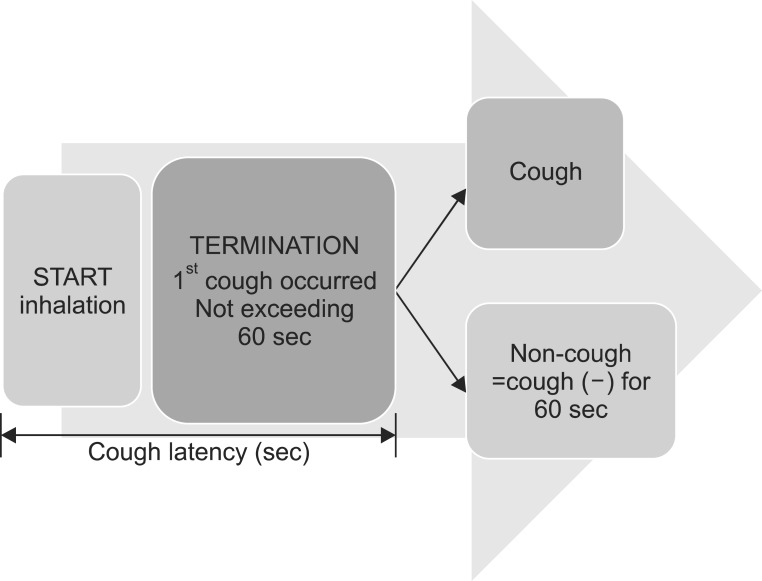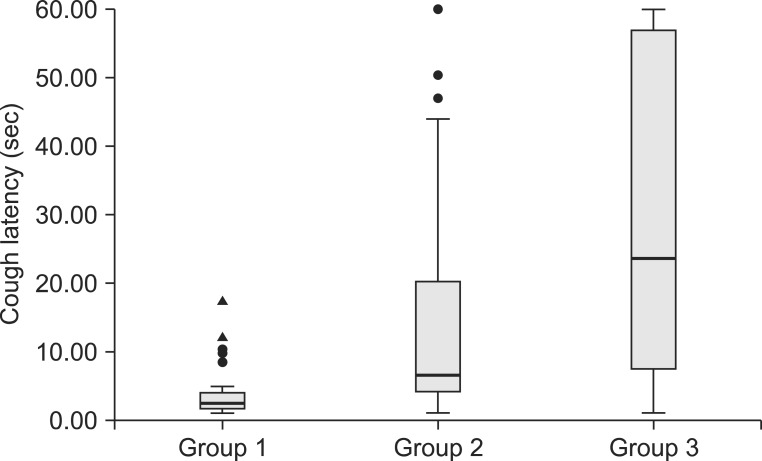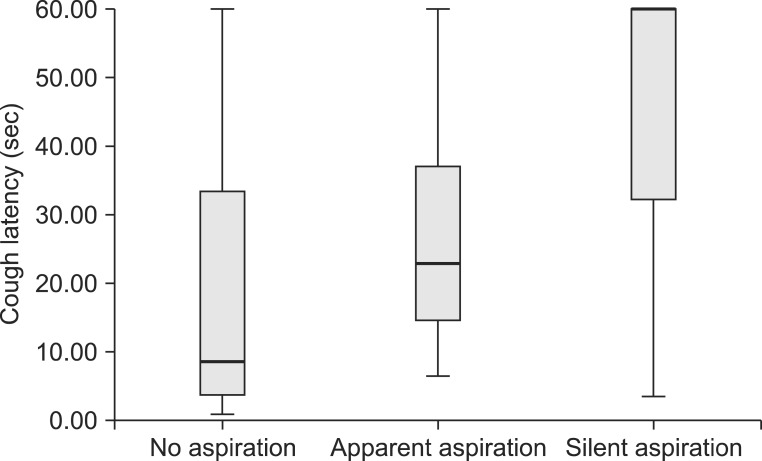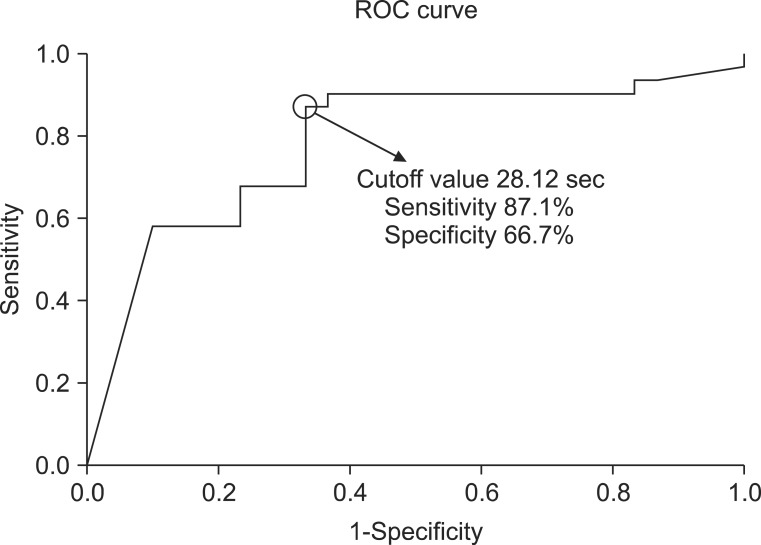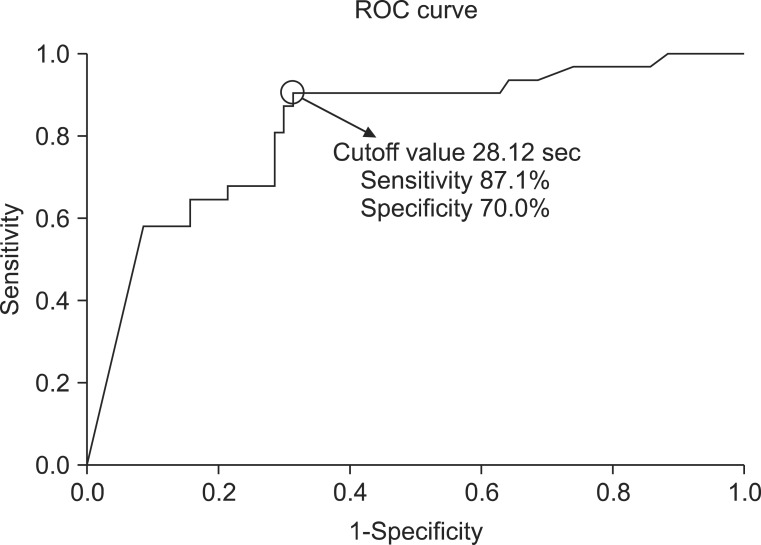Ann Rehabil Med.
2014 Aug;38(4):476-484. 10.5535/arm.2014.38.4.476.
Usefulness of the Simplified Cough Test in Evaluating Cough Reflex Sensitivity as a Screening Test for Silent Aspiration
- Affiliations
-
- 1Department of Physical Medicine and Rehabilitation, Chung-Ang University College of Medicine, Seoul, Korea. donkim21@cau.ac.kr
- KMID: 2165730
- DOI: http://doi.org/10.5535/arm.2014.38.4.476
Abstract
OBJECTIVE
To assess cough reflex sensitivity using the simplified cough test (SCT) and to evaluate the usefulness of SCT to screen for silent aspiration.
METHODS
The healthy control group was divided into two subgroups: the young (n=29, 33.44+/-9.99 years) and the elderly (n=30, 63.66+/-4.37 years). The dysphagic elderly group (n=101, 72.95+/-9.19 years) consisted of patients with dysphagia, who suffered from a disease involving central nervous system (ischemic stroke 47, intracerebral hemorrhage 27, traumatic brain injury 11, encephalitis 5, hypoxic brain damage 3, and Parkinson disease 8). The SCT was performed using the mist of a 1% citric acid from a portable nebulizer. The time from the start of the inhalation to the first cough was measured as the cough latency. All the dysphagic patients underwent the videofluoroscopic swallowing study.
RESULTS
The cough latency was more significantly prolonged in the healthy elderly group than in the healthy young group (p<0.001), and in the dysphagic elderly group than in the healthy elderly group (p<0.001). The sensitivity and specificity of SCT were 73.8% and 72.5% for detecting aspiration in the dysphagic patients, and 87.1% and 66.7% for detecting silent aspiration in the aspirated patients.
CONCLUSION
Cough latency measured with the SCT reflects the impairment of cough reflex in healthy elderly and dysphasic subjects. The results of this study show that the SCT test can be a valuable method of screening aspiration with or without cough in dysphasic patients.
Keyword
MeSH Terms
-
Aged
Brain Injuries
Central Nervous System
Cerebral Hemorrhage
Citric Acid
Cough*
Deglutition
Deglutition Disorders
Diagnosis
Encephalitis
Humans
Hypoxia, Brain
Inhalation
Mass Screening*
Nebulizers and Vaporizers
Parkinson Disease
Reflex*
Respiratory Aspiration of Gastric Contents
Sensitivity and Specificity
Stroke
Citric Acid
Figure
Reference
-
1. Palmer JB, Pelletier CA, Matsuo K. Rehabilitation of patients with swallowing disorders. In : Braddom RL, editor. Physical medicine and rehabilitation. 4th ed. Philadelphia: Saunders;2011. p. 581–600.2. Ebihara S, Ebihara T. Cough in the elderly: a novel strategy for preventing aspiration pneumonia. Pulm Pharmacol Ther. 2011; 24:318–323. PMID: 20937403.
Article3. Nakajoh K, Nakagawa T, Sekizawa K, Matsui T, Arai H, Sasaki H. Relation between incidence of pneumonia and protective reflexes in post-stroke patients with oral or tube feeding. J Intern Med. 2000; 247:39–42. PMID: 10672129.
Article4. Perry L, Love CP. Screening for dysphagia and aspiration in acute stroke: a systematic review. Dysphagia. 2001; 16:7–18. PMID: 11213249.
Article5. Widdicombe J, Singh V. Physiological and pathophysiological down-regulation of cough. Respir Physiol Neurobiol. 2006; 150:105–117. PMID: 15878697.
Article6. Widdicombe J, Fontana G. Cough: what's in a name? Eur Respir J. 2006; 28:10–15. PMID: 16816346.
Article7. Ebihara S, Ebihara T, Kohzuki M. Effect of aging on cough and swallowing reflexes: implications for preventing aspiration pneumonia. Lung. 2012; 190:29–33. PMID: 22033612.
Article8. Bours GJ, Speyer R, Lemmens J, Limburg M, de Wit R. Bedside screening tests vs. videofluoroscopy or fibreoptic endoscopic evaluation of swallowing to detect dysphagia in patients with neurological disorders: systematic review. J Adv Nurs. 2009; 65:477–493. PMID: 19222645.
Article9. Wakasugi Y, Tohara H, Hattori F, Motohashi Y, Nakane A, Goto S, et al. Screening test for silent aspiration at the bedside. Dysphagia. 2008; 23:364–370. PMID: 18594914.
Article10. Sato M, Tohara H, Iida T, Wada S, Inoue M, Ueda K. Simplified cough test for screening silent aspiration. Arch Phys Med Rehabil. 2012; 93:1982–1986. PMID: 22676905.
Article11. Ebihara S, Ebihara T, Kanezaki M, Gui P, Yamasaki M, Arai H, et al. Aging deteriorated perception of urge-to-cough without changing cough reflex threshold to citric acid in female never-smokers. Cough. 2011; 7:3. PMID: 21711545.
Article12. Newnham DM, Hamilton SJ. Sensitivity of the cough reflex in young and elderly subjects. Age Ageing. 1997; 26:185–188. PMID: 9223713.
Article13. Dicpinigaitis PV. Cough reflex sensitivity in cigarette smokers. Chest. 2003; 123:685–688. PMID: 12628863.14. Fujimura M, Kasahara K, Kamio Y, Naruse M, Hashimoto T, Matsuda T. Female gender as a determinant of cough threshold to inhaled capsaicin. Eur Respir J. 1996; 9:1624–1626. PMID: 8866583.
Article15. Mazzone SB. Sensory regulation of the cough reflex. Pulm Pharmacol Ther. 2004; 17:361–368. PMID: 15564077.
Article16. Mazzone SB, Canning BJ, Widdicombe J. Sensory pathways for the cough reflex. In : Chung K, Widdicombe J, Boushey H, editors. Cough: causes, mechanisms and therapy. Oxford: Blackwell Publishing;2003. p. 161–171.17. Harsoliya MS, Patel VM, Pathan JK, Singh S, Rahman A. A review: mechanism of cough. Int J Pharm Biol Arch. 2011; 2:840–846.18. Sekizawa K, Ujiie Y, Itabashi S, Sasaki H, Takishima T. Lack of cough reflex in aspiration pneumonia. Lancet. 1990; 335:1228–1229. PMID: 1971077.
Article19. Gilbert R, Logan S, Moyer VA, Elliott EJ. Assessing diagnostic and screening tests: Part 1. Concepts. West J Med. 2001; 174:405–409. PMID: 11381009.
Article20. Langmore SE. Evaluation of oropharyngeal dysphagia: which diagnostic tool is superior? Curr Opin Otolaryngol Head Neck Surg. 2003; 11:485–489. PMID: 14631184.
Article21. Kelly AM, Drinnan MJ, Leslie P. Assessing penetration and aspiration: how do videofluoroscopy and fiberoptic endoscopic evaluation of swallowing compare? Laryngoscope. 2007; 117:1723–1727. PMID: 17906496.
Article22. Smith J, Owen E, Earis J, Woodcock A. Cough in COPD: correlation of objective monitoring with cough challenge and subjective assessments. Chest. 2006; 130:379–385. PMID: 16899835.

